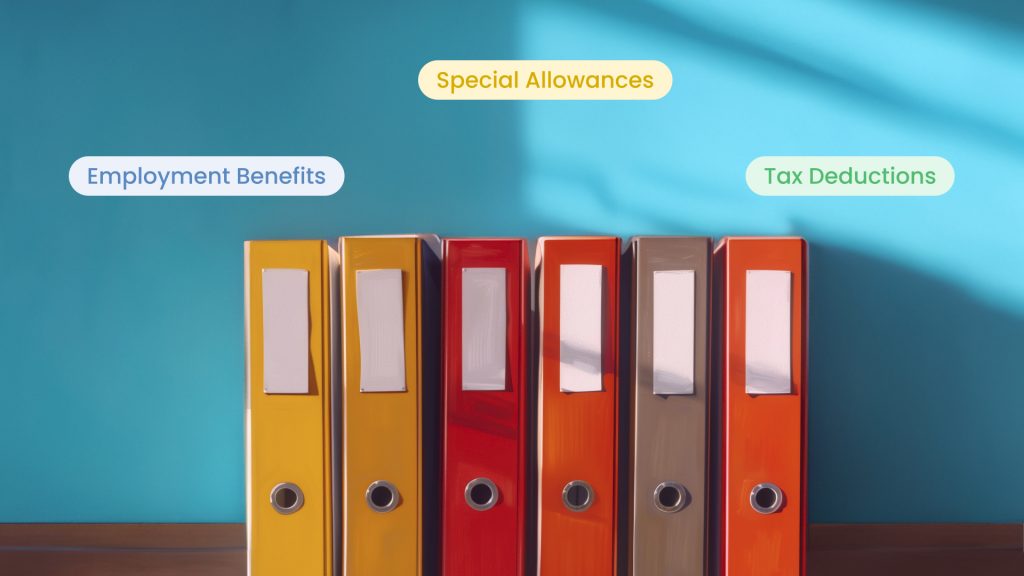As an employer in Singapore, the tax law mandates you to prepare and submit employment income details for all employees every year. Understanding the intricacies of an IR8A form and its submission process is important to maintain compliance and avoid potential penalties.
This guide will explore what the IR8A form entails and how you can file it for your employees to the Inland Revenue Authority of Singapore (IRAS), including the crucial Auto-Inclusion Scheme (AIS).
Relevant reading: Understanding the Singapore Employment Act
What is Singapore IR8A Form?
The Singapore IR8A form documents and reports an employee’s income to the Inland Revenue Authority of Singapore (IRAS).
As part of taxation in Singapore, every employer in Singapore must complete this document for every employee and state their earnings or income for the year. Due to its mandatory nature, the IR8A form should be a crucial component of your employee data management to ensure compliance with regulations.
The IR8A form is then submitted to the IRAS each year along with supporting documentation if applicable.
The supporting documents to the IR8A form include:
- Appendix 8A
- Appendix 8B
- Form IR8S (if applicable).
When is the deadline for Singapore IR8A Form?

The IR8A form must be filled out for every employee before 1 March of the year. Failing to submit before the deadline may lead to fines under Section 94 of the Income Tax Act.
A company can be given a fine of up to $1,000 or imprisonment of up to 6 months if found defaulting in the submission of the Singapore IR8A form.
What information is included in the Singapore IR8A Form?
Some of the information on a typical IR8A form are:
- Gross Salary
- Leave Pay
- Wages and Overtime Pay
- Bonus
- Others like: director’s fees, allowances, pension and gratuity
The parts to be filled out depends on whether it applies to each employee.
As mentioned earlier, you may also need to provide supporting paperwork with the IR8A form. This can be Appendix 8A, Appendix 8B, or Form IR8S, depending on various reasons.
Appendix 8A
As a Singaporean employee receiving non-monetary perks, you’re required to complete Appendix 8A. The purpose of this form is to declare any “in-kind” or “non-cash” benefits outside employee salaries. The benefits can include fringe benefits like insurance, gym memberships, free parking, or educational aid, separate from your salary.
Appendix 8B
You’re required to attach Appendix 8B to your IR8A form if you’re a Singaporean employee who has participated in Employee Stock Option Plans (ESOPs). The same rule applies if you’re enrolled in other forms of Employee Share Ownership (ESOW) plans. If an employee has ESOP or ESOW plans, it means they can buy or own company stock. Any profits or gains derived from the stock option must also be taxed.
Form IR8S
Completing this form is mandatory if you’ve overpaid CPF on your employees’ salaries or if you plan to claim a refund for such excess contributions. For the latest contribution rates, please refer to the official CPF website.
Who needs a Singapore IR8A Form?
The Singapore IR8A form must be completed for all employees to report to the IRAS on the income/earnings of each employee.
This includes:
- Part-time employees who are Singaporean or permanent and full-time resident employees.
- Employees who are not based in Singapore but were required to render service in Singapore during the year.
- Employees who are receiving a pension while they are working for the company.
- Employees who no longer work in the company but are still owed money from the year to be filled.
- Company director of non-resident corporations.
- Board members who are receiving Board/Committee Member Fees.
- All local business owners and managers.
Who are those excluded from filing the IR8A form?
- Post-clearance foreign employees who didn’t provide employee services in Singapore for the year that the form is filled.
- Non-executive directors, not classified as employees, must be informed by AIS (Auto Inclusion Scheme) employers to report their income separately on their tax returns.
- Employees who were based outside of Singapore for the year and supplied their services strictly outside of Singapore.
- Those who have left the company and/or the country (a Form IR21 is sent to IRAS in this situation).
How to file the Singapore IR8A Form?
Due to the confidential nature of IR8A form to both employers and employees, it must be filed accurately. Here’s what you need to consider when filing for the Singapore IR8A form:
But before we begin, we must understand the Auto Inclusion Scheme.
What is the Auto Inclusion Scheme (AIS)?
The Auto Inclusion Scheme (AIS) was created to make income and tax filing for Singaporean employees convenient. With AIS, IR8A information for employment income can be electronically submitted, processed, and approved automatically, ensuring accurate filling of IR8A forms.
While it is optional for businesses with five or fewer employees, AIS is mandatory for those with more than 5 employees. Providing employees with a copy of their IR8A forms is advised for record-keeping purposes.
Steps to File Your Singapore IR8A Form
1. Join the Auto Inclusion Scheme (AIS)
To register your business for AIS, head over to the My Tax Portal. You will need the UEN (Unique Entity Number) of your business or your SingPass.
2. Link your CPF data with AIS
Linking your employees’ CPF data with AIS streamlines the submission process, authorizing IRAS to retrieve both employment income and CPF information from the CPF Board. This allows IRAS to automatically get the salary details when you’re submitting Employment Income Records via AIS, simplifying the process for you.
To link your CPF data with AIS:
- Register for linking CPF data at the ‘CPF Data Link-up Service’ section on myTaxPortal.
- Connect your payroll system to AIS.
- Transfer your employees’ CPF data into AIS.
- Generate an employer submission form in AIS and submit the form with your CPF details.
3. Gather income records
To avoid mistakes, keep all the income records you need for submission in handy. Here are some things to remember:
- If you’re the owner of a business or part of the partnership, your salaries are taxed differently because you own the company. So, your income details aren’t included in AIS.
- If an employee leaves and comes back within the same year, you need to combine their income records to show this.
- If you have non-resident directors, you need to include their income details when you submit to AIS.
- If your company hires trainees under an employment contract, include their income details in AIS. But if you only provide them with allowances for travel and meals, you don’t need to include that in AIS.
- You are required to submit income details for any foreign employees on your payroll, regardless of how long they’ve worked or how much you paid them.
4. Report employee earnings
At this point, you should have filled out your IR8A form and other forms where applicable. You can do it all electronically because you have registered for AIS. No physical copies are needed, and the AIS system will automatically fill in all the data in your employees’ electronic Income Tax Returns.
5. Submit the employment income records
The IRAS has several ways of submitting employment income records. You can choose to submit directly at the myTaxPortal or via the Provident and Tax (PAT) system.
IRAS also works with HR management software to help employers submit employment income information. To easily submit records to IRAS, you can use payroll software integrated with the AIS API service.
Can I make changes after submission?
It is best practice to thoroughly review all details before submitting the Singapore IR8A form and its supporting documents. However, errors may occur. If you notice mistakes in employee IDs, income deductions, or other fields, promptly submit amendment files.
For this process, you should:
- Include income records of the affected employees.
- Specify any differences in amounts, if applicable.
- Fill in only the fields you wish to change.
- If amendments affect figures in the IR8A form, submit an IR8A amendment file along with amendments to IR8S, Appendix 8A, and Appendix 8B.
Omni Tip: To update employee identity or demographic details (like date of birth, and nationality), simply send an email to myTax Mail to get it sorted.
What are the scenarios requiring supporting documents for the Singapore IR8A Form?

Supporting documents may be required for the Singapore IR8A form in cases like:
Employment benefits
For additional perks provided to employees beyond their salary, such as housing allowances, stock options, or bonuses. Supporting documents including official letters detailing the benefits or receipts for expenses covered by the employer might be required.
Tax deductions
In cases of expenses that can be subtracted from an individual’s taxable income, supporting documents such as receipts or invoices may be required.
Special allowances
There are specific payments or allowances provided to employees for particular purposes like transport or meal allowances. Documents will need to be provided showing the utilization of the allowances.
Omni for Secure Singapore Tax Compliance
Undoubtedly, Singapore taxation is a complex and detail-oriented process that requires a deep understanding of the region’s unique regulations and a commitment to accuracy and compliance. This is especially the case when it comes to preparing and filing the Singapore IR8A form. That’s why it’s important to have the right HR technology to make things easier.
Omni offers a comprehensive payroll solution tailored to Singapore’s specific requirements. With features like support for SGD, automated tax calculations, and managed CPF contributions, Omni can help HR teams simplify their payroll processing and ensure easy preparation of the IR8A form.
With secure and centralized employee records, HR teams can swiftly access employment contracts and essential documents that support the preparation and filing process for the Singapore IR8A form.
If you’re ready to take your Singapore tax compliance to the next level, start your 14 day free trial today and experience how Omni can transform your HR processes, saving you time, reducing administrative burdens, and enhancing overall efficiency.


